Writing a novel can drive you crazy. There are all these characters running around yakking their heads off and doing weird things. Sometimes I feel like I have no control over any of it.
It makes me think I need one of those big ugly organizational flow charts you might see on the wall of oh, I dunno, the IRS?
Crazy, right? Well, if I’m nuts than so is J.K. Rowlings. And Norman Mailer. And Joseph Heller. And Henry Miller.
Because all of them, I found out this week, make drawings and charts and elaborate maps to help them find their ways through the thicket of plot and characters. Check this out:
This is J.K. Rowling’s spreadsheet plan for
Harry Potter and the Order of the Phoenix. (Click to make image larger…you’re gonna need it). And below is Norman Mailer’s drawing for
Harlot’s Ghost. (To see other famous writer examples
CLICK HERE.)
At first this made me think of that axiom about sausage-making and the law, that it’s better not to see them being made. Don’t we all — readers and writers alike — want to believe that novels arise from some deep mystic well of creativity? But then I realized that no, I really enjoy it when I get a glimpse of the architecture beneath a novel. And like I said, it also makes me feel less…nuts.
We talk alot here at The Kill Zone about the difference between plotters vs pantsers. (ie do you outline or do you wing it?). But we never talk about the picture makers. I am a picture maker. I can’t keep control of my story, can’t control its pacing and rhythms, can’t really SEE where it’s going, unless I draw it.
I used to think I was alone in this but I found out many authors use some kind of story boarding. Some even use software for it, Scrivner being a favorite. My dear late friend Barbara Parker had beautifully rendered storyboards on her office wall that would have made any Hollywood mogul proud. My scribbles aren’t nearly so neat but they do the job. It also something born of necessity because if you work with a collaborator, you both have to be literally on the same page.
My co-author sister Kelly and I happened upon our methodology by accident about nine books ago. She was visiting me here in Florida and one day I came home and saw this:
Kelly had written all our plot points down on scraps of paper and taped them to a board. (The wine is an optional but vital writing tool). We found this was a quick way to visualize our plot, move chapters or add things. It also acts as a chronology and time line, which is valuable during rewrites.We eventually graduated to Post-It notes. And the PLOT BOARD, as we call it, became more complicated as we refined our methods:
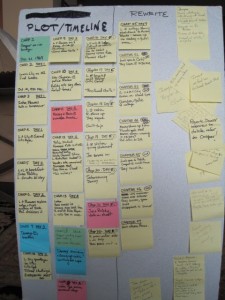
One Post-It per chapter, each with the salient plot points in that chapter. Usually, our Louis Kincaid books are written only from his POV so it’s all yellow. EXCEPT: we sometimes use pink for what we call “personal” chapters. This is because as we mix “case/plot” chapters with character-development chapters (ie personal) we are constantly aware of the need to keep the main plot moving. Too many pinks in a row? That’s death in a suspense novel so we find a way to distribute that extra pink stuff around. It’s all about pacing. This board above, however, is for
HEART OF ICE, which is a more complex plot. It has five POVS, so we use a different color for each. Again, it helps with pacing.
But we do more than just plotting on boards. We often need some pretty elaborate drawings, maps, and charts to keep track of things.
This board above was for
THE LITTLE DEATH. The plot concerns multiple bodies found in disparate locations in Florida’s cattle country. Louis finds no connections between the murders until he digs deep into each victim’s life. This board helped up keep the victims’s backgrounds straight as well as where the bodies were found in relation to each other (an important clue).
Here is a board for
A THOUSAND BONES. This book drove us nuts because the plot, about a serial killer operating over almost 20 years, was very complex. Its backstory begins in 1964 and the main plot moves to 1990. The killer left tree carvings with each victim but the carvings changed as he got older. We had to kept track of each girl’s backstory, where the body was found (the color coding), what personal items were found with each, and what carving.
We do a lot of family trees. This one above was for
SOUTH OF HELL. Almost none of these characters appear in the book but we had to know who begat who, mainly because Louis happens upon an old family Bible that helps him solve the case. In another book, ISLAND OF BONES, there is a weird multi-generational family living on a remote island in the Florida gulf and Louis discovers a cemetery where the headstones give him major clues. The family tree was so tangled our publisher even put a diagram in the book.
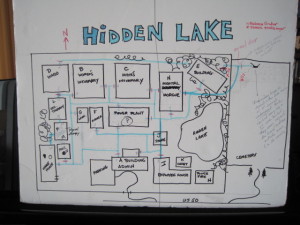
Above might explain why, despite the fact I was an art major, I do not make my living that way. Seriously, it is a drawing I did for our book AN UNQUIET GRAVE. It is set in an abandoned insane asylum and because I was having trouble explaining to Kelly how I pictured the grounds and buildings, I drew this for her. The blue connecting lines? Those are the tunnels in which our hero Louis gets lost and almost killed.
One of the biggest problems I think many manuscripts have is that the reader can’t VISUALIZE the physical action ie the moving around in physical space of the characters. Because the writer has not done an adequate job of describing places and actions, we are confused. And maybe it’s simply because the writer did not take the time to “draw” things out in his own mind. It’s important that a writer be able to clearly SEE a story so that the reader can as well.
Speaking of seeing stuff…
This is our character board. We started it about twelve years ago just for fun. One day, feeling burned out after a hard day writing, we started thumbing through magazines finding pictures of people we thought looked like our characters. On here you’ll find Louis’s foster father Phil (actor Michael Rennie), his old boss Chief Wainwright (coach Bill Parcells), his lover Joe Frye (a young Charlotte Rampling), his best friend Mel Landeta (fellow author Jon King) and Roland the serial killer (a random shot we found on the State of Florida Department of Corrections website of mug shots). We did this for fun but, again, when you have two brains creating characters, it helps it you can visualize a real face.
Postscript: A couple days after I wrote this, I met with my critique group. They were having problems with a scene I had written where a character gets thrown out of a car on I-75. My mates couldn’t VISUALIZE what I had described and I found myself saying “Yeah but this is what I meant!” In frustration, I drew them a picture of the road and the swale, the car’s position, a little stick man body, etc. They all looked at me, shaking their heads, and one said, “Well, that’s not what you wrote.”
Bingo. Once I drew it, I realized I had everything wrong, including what side of the highway they were on.
What about you guys? I know we’ve got pantsers and plotters out there. Any picture makers? Send me your examples and we’ll do a follow up. Send them to killzoneblog at gmail dot com. (Sorry, gotta spell it out to avoid spammers) Show me your pictures!

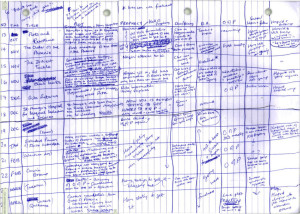
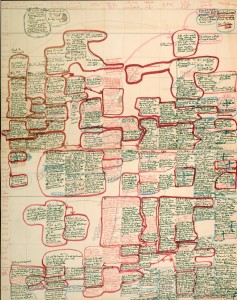


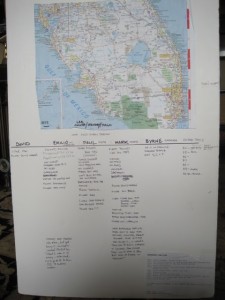
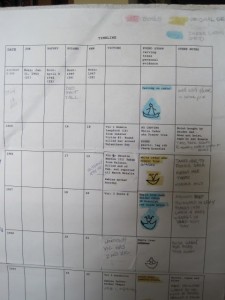
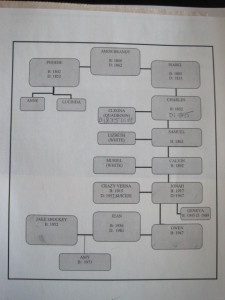

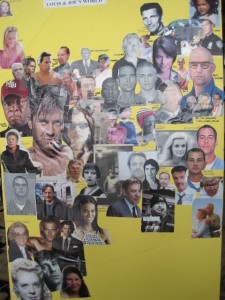
Great post!
I think that I will story-board it:)
Don’t mean to hog any bandwidth, but your post really ‘got me thinking’.
Is God a plotter or pantser?
I tend to believe that God is a plotter.
Well how could The Great One, be anything else.
All of these little stories, characters, rocks and planets, Quarks … well it is just mind numbing.
Could God’s storyboard be what Carl Jung called the “collective unconscious”, or Cayce’s “hall of records”?
I am currently 57000 words into my attempt on a first novel, and cannot remember who done what. I think it is about time to dip toes in water, and try this plotting maneuver.
Thanks P.J. for the visual.
Dave, you get the award for the best cosmic question of the month re God being a plotter. I like to think of Him that way but I also think He has a really good sense of humor and a healthy respect for serendipity.
I’m a hybrid pantser. I fall more into the “wing it” camp than a full on plotter. I’m too impatient to do an outline. I “think” about the large plot movements, like how it will start, who are my main characters, what are the stakes & conflicts, and what is the black moment when all seems lost. I work hard at the start, then make chapter notes as I go forward, so I have scenes in 1-2 chapters ahead.
Of late, however, I’ve seen the importance of better organization to avoid the inevitable stall out half way through. I’ve posted my new method at TKZ in something called “The Bucket List for Plotters” (I think that’s the title).
So now I start with the 3-act screenplay structure (a big W in plot turns), then do a storyboard of chapters using sticky notes, starting with 25 things/scenes I know should be in the book. I also do images of characters and locations/settings, saved on my computer to use when I’m writing the scene. I also listen or pick music to get me in the mood, if a certain song does that.
But I am definitely adding the wine component.
Great post!! Love the visuals. Hope you get some interesting pics.
Jordan: Do you remember when your bucket list post ran? I wanted to link to it.
The Author’s Bucket List on Plotting Structure was posted on 3/1/12. Thanks, Kris. You and your sister are amazing!
Here is where a multi-pronged use of Scrivener is so helpful. It provides a variety of visual ways to look at your plot and characters. For my current WIP I use split screen. On the left is the document I type in, on the right is a corkboard with headshots of all my major characters. A double-click on a character card takes me instantly to my one-sheet character page, if need be. Info about settings, including clippings and jpegs and maps, is in the Research folder.
My Sticky Note outlay has gone way down.
Agree. I especially like the ability to cast the characters with photos.
I tried Scrivener but gave up. I think it was just my techno-phobia thing. Plus I am adverse to almost everything these days that require me to learn something new that takes a lot of time to master. (Like golf). I’m sticking with stickies.
I bought myself one of those white boards with five colourful, erasable markers and had a lot of fun plotting and erasing and changing colours. Until I picked up a permanent black marker by mistake (for the villain, of course) and couldn’t erase the part where the villain turned out to be someone nice, just misunderstood, and screwed up my whole ending. Had to scrap that board but I’ll send a picture.
So then I bought a board that was half white, half cork so I could pin additional notes to my plot notes. That board morphed into a personal calendar for birthdays, appointments, etc. Not enough room on either board for full-out plotting. Picture 2.
I lose post it notes in amongst my ideas for blogs and the gummy stuff (don’t I have a way with words) loses its gumminess when toast crumbs get all stuck on them. Picture 3.
Now I just use Hiveword.
LOL! re the black marker thing. He was a very persistent villain apparently.
Never heard of Hivewood…must check it out.
This is terrific advice! I’ve learned through my critique groups that writers often falter because the writer is not conveying what he sees in his mind to the reader. It seems obvious, but it is very easy to lose the delicate connection between writer’s imagination and the reader’s experience. Something can be so clear in our head that we assume it’s been somehow teleported into the reader’s mind. Making sure we have very specific visuals laid out for ourselves is the first step toward creating a successful image transfer to the reader. Thank you for sharing your examples, and I look forward to seeing some from the TKZ’ers.
Kathryn: I agree on your comment about writers faltering because they can’t describe what is in their heads. It’s the most basic problem with manuscripts. And what’s odd is that often the writer can’t see the problem even when it is pointed out to them.
I write with Scrivener, and I love the cork board feature which really helps me see the overall picture. I also collect inspiration pictures for scenes/settings/character faces, etc. I been there and done that when it comes to “the thoughts in my head” do not translate to the page in the way it should.
When I get home I’ll send over some of my sketches. One of my works in progress is a Sci Fi Epic following an ensign as she rises to command a ship of the line. I tried to do the combat scenes just from my mental image and realized that I had to actually plot out (and draw) the entire bridge, the ship, organizational charts, ranks, protocols, and sketch the aliens themselves so I could be consistent with the descriptions.
And even with that I still had to go in and do MORE sketches of the UI for the ship’s command stations so that I could see what it was I was trying to describe.
I really need to get back to work on that….
Rob, re combat scenes: My sister and I have actually resorting to pantomime and acting out physical scenes. Once, we were sitting on the beach with her little grand daughter and we were trying to figure out a fight scene. We picked up a plastic blow-up whale and used it as the stabbing victim. People probably thought we were nuts.
OMG!! This is why I charish this blog page!! I thought my best friend, and co-author, and I were the only crazy people who did off the wall stuff like this!! I remember, I’ll spare the details of not showering and brushing my teeth because I had to get a scene out of my head first, I drove to her house in my pajamas played the music that went with my combat fight scene and acted it out for her!! This is what makes writing so much fun!! Thank you so much for letting me know we’re not alone with our insanities. 🙂
I can visualize your pajama scene perfectly Jeanette. 🙂
Fight scene in pajamas…hrm. I thought I might have looked odd stalking in the woods in a city park, but maybe not.
Basil, I think you are still clear of oddness in the woods. You may want to take care stalking under bedroom Windows though. And especially in pajamas! LOL.
PJ,
I could totally see you stabbing that poor innocent whale. I love what the mind can create!!
I use a poster size plotting board, divide it into chapters, and stick up Post-Its in the initial plotting stages. After I’ve written the chapter, I’ll fill in the square with different colored inks. Nowadays I’ll also do a Pinterest story board for my novels. It’s fun picking out the pix at the royalty free sites.
I love that I can come here and find such like minded people, even as individual as we are. My life has been opened up to a whole new world of individuals that are crazy like me!! 🙂 I mean that in the most endearing way. My best friend and co-author and I share photos of stars or models that we would want to represent our characters. I keep file folders of research materials, photo inspirations, inspirational music (Imagine Dragons have been the biggest inspiration), plot developments, and deleted scenes. She even created a slideshow of our characters. Doing out a storyboard though I think is an ingenious idea! I will need to get to work on that ASAP!! Thank you so much!! Now can you tell me how to shift my concentration back to homework because I have an 8 to 10 page paper due in my psychology class?! Oi vey!!
I’m a plotter and a picture maker. I too have big poster sheets with post it notes stuck on it as I outline my books. I also graph the book once I’ve finished the first draft just to see how the pacing is going – okay now I just sound crazy…but it’s true!
Folks, I saw one of these and Killer Nashville a couple of years back and the photos don’t do ’em justice. A collective gasp arose from those assembled, and with good reason. It’s just one of many elements which make the books as great as they are.
In the past I’ve been a straight pantser, but with the exponentially deeper layers of complexity in my WIP find myself having to pull out the creative pre-thinkerator and start drawing things out.
I’ve used scrivener in the past but had a hard time getting used to the setup. With James’ idea of using two screens I may give it a try again, although that’s not always so easy on my laptop.
As far as acting out scenes, I have hiked many miles in the forests around Anchorage to get the knowledge of the land needed for certain scenes. I’ve also spent countless hours at the shooting range, including this past Sunday, firing all sorts of weapons and doing drills requiring shooting both left and right handed, switching from rifle to pistol, speed loading different weapons and practicing knife and blunt object fighting. One great resource I have is a friend who is a class 3 licensed dealer and has all kinds of goodies, like full auto and silencers. Things like that are some of my favourite parts of this job.
Basil,
I totally get the gun thing. I am not a gun person but a couple years back I got to go to a shooting range and shoot a big variety of guns (it was arranged by our writers conference.) It was really instructional. I still use one of the experts there as a gun source.
Nope. Pantser here. Then about halfway in, I go plotter. 🙂 Great post!
I can relate to this, Dina.
Thank you so much for this post. It’s helpful to see how other writers approach plotting. For picture books, which I wrote at first, the end is only about four pages away from the beginning, so you’d have to have the IQ of a tomato to forget who your characters are or what’s going on. But with novels, I discovered, I have the toughest time remembering EVERYTHING. Therefore, I love to see how writers go about creating plot maps like these. Forget the traditional coffee table books. Someone needs to make one showing how authors create visual plot maps like these when they write. They’re tremendous.
Beth, we have trouble remembering stuff too. We have a whole book filled with character dossiers for our series. Everytime we create a character, we start a dossier for them (age, etc). It saves us a helluva lot of time when the characters show up in other books.
PJ–
Thank you for this generous, detailed post. For me, no amount of planning, mapping, outlining, etc. can substitute for the passage of time. I can’t SEE what’s missing–or should be–until something I’m working on has been drafted. Then I have to ignore it. Before I look at it again, enough time must pass for me to gain the detachment needed to see what I’ve actually written, not what I originally believed was on the page. The contrast between then and now can be very humbling.
Very true! Thank for this thought Barry. I love writing on paper (everything connected to creative writing, whether it is a blog entry or my first novel). And after several days I type it and by that do my first edit. This break seems necessary and I have a feeling that if I would type immediately then it would be like putting baking bread without leaving it to rest and grow. Best regards.
Barry: Awww. Thanks. You made my day. (or night, since it’s 7 p.m and I am getting ready to sign off and go make spaghetti.
Eureka! I am seating alone at a coffee place, but then I just realize (VBG) I’m not alone. Thanks for this. Love it.
Yes! All that and more. Just remember not to get so carried away that the reader needs to start mapping and storyboarding to keep things straight. The idea is to provide the key ques so the reader can paint pictures and visualize the story world in his head and keep moving along. Do I really need to open up Google Earth and follow along through the streets of Paris? Sometimes it sounds like fun when reading Alan Furst.
I just picked up A Death in the Lucky Holiday Hotel by Pin Ho and Wenguang Huang. Here I just might resort to Google Earth.
I do stringer work for a small local newspaper. Pure fluffy bunny stuff. I was covering the prom when a kid and his date glided by.
They were striking. Not just pretty, but small-town-eugenics-project striking. I stopped them and got their pic (it was pretty cool, my prom spread was the entire back page).
However, I kept coming back to the photo. And then it hit me. In the WIP, my MC sees a high school photo in the FBI agent’s wallet. She asks if it is his brother and he replies that it is his son (with a bit of backstory on being a teenage father). Originally, that pic was a kid in a football uniform. Guess what that pic is now?
I have a piece of an old cubicle with padded fabric walls (long story). That is my storyboard. I pushpin whatever strikes my fancy onto it. I have it packed to go to the new house, or I’d sub the photo.
Terri
Very encouraging post for aspiring writers. Thank you very much!
I have a note-book especially for notes on characters and plot and all the brainstorming details for the my first novel. Different ideas are really great. I guess, when doing this digitally, especially if you and your co-author live far way you could do it by using Cmaps http://cmap.ihmc.us/ I use it a lot in my daily work, but I can imagine using it also for creating writing. Local use is also possible.
Thanks again for great ideas and good luck to all.
Wow! I love this blog. I’m a visual learner (former visual artist too) and I’ve got plot diagrams all over the place, but they haven’t really geled. Maybe color post-its are the way to go to keep characters and internal/external plot points straight.
Good advice, thanks for the window on to your world.